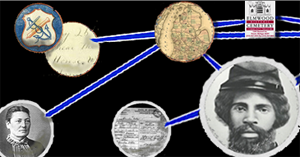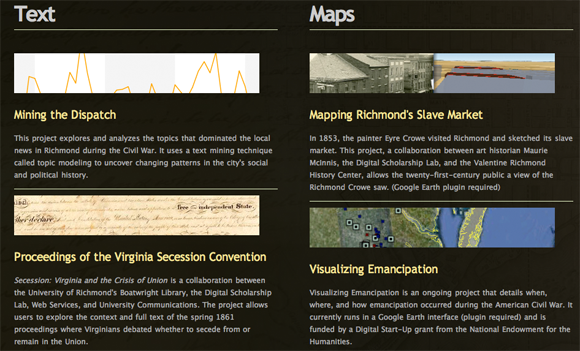 April 2011 marks the 150th anniversary of the first hostilities of U.S. Civil War, and museums, municipalities, historic sites, and schools are making their preparations for the events and exhibits to commemorate it. While, no doubt, times are tough for funding cultural heritage projects, there’s a lot of excitement around the sesquicentennial, making it a great opportunity for those exploring how technology can make history more interactive.
April 2011 marks the 150th anniversary of the first hostilities of U.S. Civil War, and museums, municipalities, historic sites, and schools are making their preparations for the events and exhibits to commemorate it. While, no doubt, times are tough for funding cultural heritage projects, there’s a lot of excitement around the sesquicentennial, making it a great opportunity for those exploring how technology can make history more interactive.
It’s also a great opportunity to pursue linked data efforts across these museums and historic sites, in turn making this historical information more discoverable and interoperable. That’s what the Civil War Data 150 project is undertaking, and I asked two of the project organizers — Scott Nesbitt, Civil War historian and associate director of the Digital Scholarship Lab at the University of Richmond, and Jon Voss, founder of LookBackMaps — about how the Civil War anniversary will help boost linked data and digital history efforts.
What opportunities does the sesquicentennial provide for museums, historical sites, data geeks, and developers?
Scott Nesbitt: We’re in a time of remarkable collaboration across institutional barriers. Just as an example, a wide array of institutions ranging from the Slave Trail Commission to the Museum of the Confederacy came together recently in Richmond, Virginia to commemorate Civil War and Emancipation Day. More than 3,000 visitors braved the rain to tour these sites and hear presentations about new discoveries and data sources that are still emerging. In the same way, building technical links to data currently held by institutions within a single community and across the country is really quite an opportunity.
Jon Voss: The cultural heritage community has been preparing for the sesquicentennial for several years — it’s a huge opportunity to engage and educate new audiences about the Civil War. Many archives and libraries have been bringing their Civil War collections to the web in new ways, and we’ve seen a host of new digitization efforts as well. And while there are incredible curated exhibits and events across the country, an increasing number of institutions are recognizing the power of direct discovery and are making raw data and metadata open and accessible to developers and the general public. Combined, there’s a myriad of possibilities to discover and analyze the Civil War in new ways during the four-year commemoration.
How does linked data benefit the study of Civil War history?
Jon Voss: Perhaps the most exciting possibility of applying linked open data to Civil War history is to connect information and images across many standalone databases and view them together in any number of applications. One element of this is discovery — finding images associated with one regiment in multiple institutions, for instance. But more important is the ability to combine that information in an entirely new way. Just the ability to search across historical collections is a radical development, as search engines typically aren’t able to crawl databases. Part of what linked data does is expose metadata that’s been pretty much hidden up until now.
What are some of the new things we can learn thanks to this sort of approach?
Jon Voss: Already we’re learning about the variety and sheer amount of data out there. More than 3 million Americans fought in the Civil War, and there is an enormous amount of paper left behind, including muster rolls, medical records, food shipments, pensions, photographs, correspondence, and first-hand accounts.
Scott Nesbitt: With new links between data sources, historians will be able to imagine new questions to ask that would have been discarded as nearly impossible to answer before. We don’t know, for example, whether Union regiments made up of working-class men or farmers were more likely to go out of their way to set enslaved men and women free in the South, or whether units made up of primarily of Republican or Democrat men were more likely to confiscate food from devastated southern farms. So the possibilities for historians are exciting.
What are the most interesting data projects you see happening in conjunction with the anniversary?
Scott Nesbitt: Linked data presents an exciting challenge: How do we begin to make sense of the patterns within large datasets and between disparate kinds of data? At the University of Richmond, we have been building “Hidden Patterns of the Civil War,” a suite of projects devoted to exploring these possibilities.

“Hidden Patterns of the Civil War” collects a number of interrelated data projects.
Jon Voss: We’ve already seen some great data visualizations from media outlets like the History Channel, Washington Post, and The New York Times, and I expect to see a lot more of that as we go. But what’s on the horizon are augmented reality and location-based apps that really bring the harsh reality of the Civil War to life — there are a few of these projects already in the works. There will also be lots of opportunities for people to transcribe and map documents and photos. That will help us make the links between disparate datasets.
What’s really exciting is that all of the data we work with on this project will be permanently open and free to use.
Associated photo used on home and category pages: General John P. Hatch by The U.S. National Archives, on Flickr
This interview was edited and condensed.
Related:
